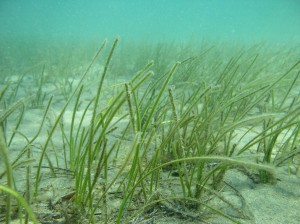We all are aware of the paramount role that seagrasses play along nearshore enviroments. Yet, declines trends in the presence of seagrasses have been worldwide described, what suppose a threat to the services these habitats provide. We performed a comparative decadal study in 21 Cymodocea nodosa seagrass meadows at Gran Canaria Island to compare the demographic structure between 2003 and 2012. In particular, we aimed at determining whether temporal trends would be predicted by a range of natural versus anthropogenic sources. We demonstrate that during this period, natural influences (sea surface temperature, Chlorophyll-a concentration and PAR light, as well as the number of storm episodes detaching seagrasses) had a low predictive power on temporal patterns in seagrass structure. In contrast, proximity from a range of human-mediated influences (e.g. the number of outfalls and ports) seem to be related to the loss of seagrass. This result highlights promoting management actions to conserve meadows of C. nodosa at the study region through efficient management of local impacts. Feel free to download the paper from the “articles” section.
-
Archives
- April 2015
- December 2014
- November 2014
- June 2014
- April 2014
- February 2014
- January 2014
- October 2013
- September 2013
- July 2013
- June 2013
- February 2013
- December 2012
- November 2012
- October 2012
- September 2012
- July 2012
- June 2012
- May 2012
- March 2012
- February 2012
- January 2012
- December 2011
- November 2011
- October 2011
- September 2011
- July 2011
- May 2011
- March 2011
- January 2011
- December 2010
- November 2010
-
Meta


